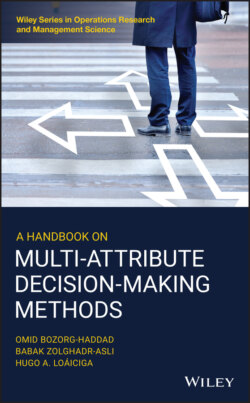Читать книгу A Handbook on Multi-Attribute Decision-Making Methods - Omid Bozorg-Haddad - Страница 13
1.2.3.2 Fuzzy Vs. Crisp
ОглавлениеCrip MADM modeling expresses the decision‐makers’ preferences with numeric values. However, there are cases in which the subjective uncertainties that are surrounding decision‐makers prevent the stockholders to express their preferences with a crisp number (Tzeng and Huang 2011). In such situations, decision‐makers may rely on a fuzzy set that can best describe the stockholders’ preferences. Fuzzy sets offer the benefit of implying linguistic evaluation, which in turn, would ease the evaluation process of the decision‐makers (Bellman and Zadeh 1970).
It is vital for decision‐makers to distinguish the fuzzy‐uncertainty logic from the probability‐uncertainty logic, and to use them in the proper context. In cases where the certainty of outcomes is in question, the probability‐uncertainty logic is the recommended tool. In such situations, the decision‐makers’ decision‐tree is founded on at least one uncertain event. Consequently, the probability of each outcome would play a role in determining the most suitable alternative. On the other hand, when the decision‐makers are not certain on how to express the preference of an alternative, the fuzzy logic becomes the favored option. Fuzzy evaluation enables decision‐makers to describe an alternative’s preference through a fuzzy set employing membership functions. In essence, while the probability‐uncertainty logic deals with the probability of outcomes in a decision‐tree, the fuzzy logic offers the possibility of preference evaluation by the decision‐makers. Exploring the realms of nondeterministic evaluation and fuzzy description of performances lays beyond the scope of this book.
